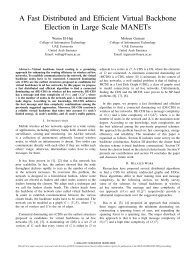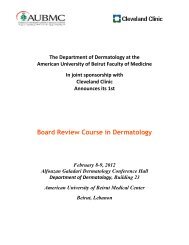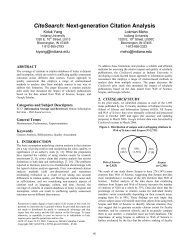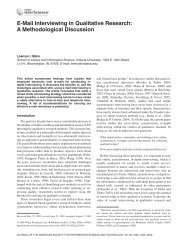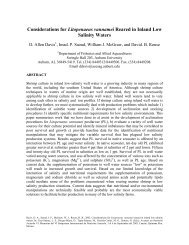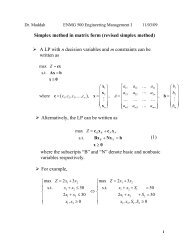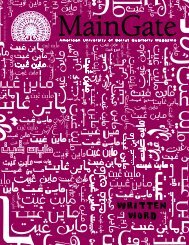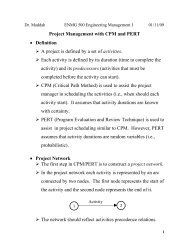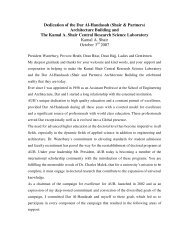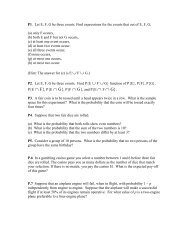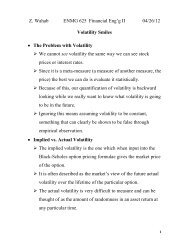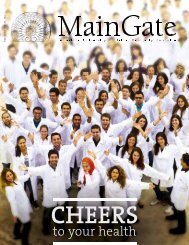Nahr el Bared Refugee Camp Crisis (Lebanon) - American ...
Nahr el Bared Refugee Camp Crisis (Lebanon) - American ...
Nahr el Bared Refugee Camp Crisis (Lebanon) - American ...
You also want an ePaper? Increase the reach of your titles
YUMPU automatically turns print PDFs into web optimized ePapers that Google loves.
<strong>Nahr</strong> <strong>el</strong> <strong>Bared</strong> <strong>Refugee</strong> <strong>Camp</strong> <strong>Crisis</strong> (<strong>Lebanon</strong>)Socioeconomic Impact Assessments and Recovery PlanFor Areas Surrounding <strong>Nahr</strong> al-<strong>Bared</strong> <strong>Refugee</strong> <strong>Camp</strong>Final ReportSubmitted to World BankSari HanafiAssociate Prof. of Sociology, <strong>American</strong> University of Beirutsh41@aub.edu.lbJune 20, 2008I. Introduction 1The <strong>Nahr</strong> al-<strong>Bared</strong> refugee camp crisis left a tremendous impact on both the regions of Akkarand Tripoli on many different lev<strong>el</strong>s: security-wise, economically and socially. One shouldacknowledge that even before the crisis, Akkar had been the poorest area in <strong>Lebanon</strong> (see map ofAkkar in annex): 63% of the families living in Akkar are deprived of their basic needs and faceserious poverty (UNDP, 2007) (see also Graph 1 in annex). Lab<strong>el</strong>ed as the forgotten Akkar,(Mouchref, 2008) as w<strong>el</strong>l as the deprived and the disadvantageous (Nehmeh, 2007), this district– the lead rural area in <strong>Lebanon</strong> – comes first in terms of poverty and therefore an interventionwas staged in order to meet the needs of the Akkar population and allocate some resources forthe poor in the region. According to the mapping of the living conditions in <strong>Lebanon</strong>, the mostfour deprived sided districts (kadaas) are Bint Jbeil, Herm<strong>el</strong>, Akkar and Marjayounconsecutiv<strong>el</strong>y according to the classification of the kadaas having a percentage of deprivedfamilies exceeding 60% of the total residents of the Kadaa.Thus Kadda Akkar ranks the first among all districts in <strong>Lebanon</strong> in terms of poverty anddeprivation. If we take into consideration the deprived population number of every district andcompare that to <strong>Lebanon</strong>’s population, Akkar’s holds 12.5% of the total number of deprivedpeople in <strong>Lebanon</strong>.1 I am grateful to all resources. People I’d like to thank are all the mayors and civil societyactors who give me some of their precious time to provide me with information and to commenton this report, especially Aicha Mouchref, Clement-Nadim Zakhia, Ahmad Jehjeh and AliaShaban.
The situation of Akkar is endemic and has been a result of many historical reasons leading to itsproblems in social structure and political economy that date back to the 1960s. Throughout 1959to 1960, a national survey by the Lebanese Ministry of Planning established the coastal plain ofAkkar as the poorest and most deprived area in the country (IRFED 1959-60). The main attributeof the area was the feudal nature of society, with a ruling <strong>el</strong>ite of large estate owners (bey, pl.bekawat) controlling landless labourers and tenants working as sharecroppers on the feudalestates. Remnants of this feudal system (iqtaa), persisted into the early 1970s (Gilsenan 1996;quoted by Knudsen, 2006). The tribal system has been replaced by the extended families’ powerstructure.Similarly, the regions of Dinniyeh and Tripoli have been identified by different studies as beingamong the poorest and most vulnerable of <strong>Lebanon</strong>. The mohafazat of the North also have thehighest “inter-governate inequality” in <strong>Lebanon</strong>, meaning that these mohafazat have the widestgap between the rich and the poor. Tripoli and Akkar are extrem<strong>el</strong>y poor while Zghorta, Koura,Batroun and Bcharre have a r<strong>el</strong>ativ<strong>el</strong>y low poverty rate (Mouchref, 2008).This need assessment report will focus on two rings of localities surrounding the <strong>Nahr</strong> al-<strong>Bared</strong>camp. The first ring is composed of Beddawi, Minieh, Bhanine, Deir Ammar, Bebnine andMuhammara. The second ring that was defined by the Council for Dev<strong>el</strong>opment andReconstruction (CDR) in close consultation with the Prime Minister covers the followingmunicipalities: Aayoun Ghozlan, Raouda, Beit <strong>el</strong> hash, Ranaiyé, Hakour, Miniara, Bqerzla,Dahr Ayas, Al Qarqaf, Mar Touma, Majdala, Borj El Arab, Bzal, Al Rihanieh, DeirDalloum and Halba. With regards to sectarian divisions, all of these localities are Sunniteexcept Mar Touma and Halba (mixed cities), first inhabited by Greek Orthodox families, whowere later joined by Sunnis and Maronites as w<strong>el</strong>l as families of other Christiancommunities(World Bank, 2006).Akkar is not a homogeneous area: we can speak of different clusters of populations. However,whilst looking to the concerned localities of the two rings, one may easily realize that theyb<strong>el</strong>ong to a predominantly poor cluster. Two factors apparently played a vast role in the socioeconomicsituation of this region: outmigration and the role of the diaspora from one side and themissionary schools from the other side. Historically, the outmigration from the Christianlocalities (particularly the area of al-Joumeh: Beino and Qobayyat and Bazbina, Jibray<strong>el</strong>, Rahbeand Beit Mallat) has been much more important than that from the Muslim localities 2 . Some ofthe emigrants send remittances regularly and others even subsidize some of their municipalityprojects. One should add to that the presence of the good missionary schools in these localities.Many Christian localities constitute a better off cluster compared to the Muslim clusters 34 .2 More generally, income disparities appear to be corr<strong>el</strong>ated with confessional identities; poorand Muslim and rich and Christian. In a country where income disparities may have played amajor role in triggering the war, growing social inequalities could again destabilise the country.See Are Knudsen (2006)3 Again as Mouchref noted (2008) at the governorate lev<strong>el</strong> disparities in poverty also exist. Forexample, “villages like Beino and Qobayyat have a r<strong>el</strong>ativ<strong>el</strong>y higher living standard than povertypockets like Fnaydeq, Bibnine and Qobbet Bchamra.”
During the recent events of the second week of May, fierce clashes in the Akkar region killed 14people, including civilians, when fights occurred mainly between members of the Syrian SocialNationalist Party and supporters of the Future Movement. In another incident, seven Syrianlaborers from Aleppo and their driver from south <strong>Lebanon</strong> were wounded by gunmen who set upa checkpoint on the Minya highway.The whole economic situation in Akkar is a threat to Lebanese stability. Despite having the <strong>Nahr</strong>El <strong>Bared</strong> war positioning the large majority of the Sunni population as moderate, the Christianvillages of Akkar still live under constant fear. Some people talk about of “Village Gaulois”syndrome.Three recent factors played a major role in worsening the situation of concerned localities: theclosure of Syrian borders during and after the July war between <strong>Lebanon</strong> and Isra<strong>el</strong>, the <strong>Nahr</strong> al-<strong>Bared</strong> crisis and finally the freezing weather of February 2008 (which has affected and killedcrops).II.Some Socio-Economic and Urban DataUnderstudied localities of the first and second rings vary between Lumpen urban and rural areas.Because of <strong>Lebanon</strong>’s small size, urban migration needs not imply severing ties with the natalvillage but allows frequent visits and in some cases even commuting between the ruralhomestead and the urban workplace. A phenomenon common to rural <strong>Lebanon</strong> is theurbanization of rural areas, turning villages into agro-towns with a transient population ofresidents, migrants and commuters. This has also changed the physical lay-out of the villageswhich now resemble peri-urban townships.All these localities mainly depend on the sectors of agriculture and sometimes fishing. Sometrade activities as w<strong>el</strong>l as taxi drivers are present but very little having to do with the industrysector. (see graph 2 in annex)Table 1 in the Annex provides some data about the population size and the annual budget of themunicipalities. One can notice clearly that, when the data is available, the municipality budget isvery small. Almost all of the mayors complained of lacking financial resource for theirrespective locality. While the average family size in <strong>Lebanon</strong> is 4.7, in Akkar it is 5.6 (Nehmeh,2007). Also, in the region around <strong>Nahr</strong> al-<strong>Bared</strong>, this average is much higher reach 6 to 7.Currently, 16 per cent of the families and 22.7 per cent of the individuals in Akkar earn less than60,000 liras (LL) (US$40) per month, compared with a national rate of 4.5 and 6.3 per cent.(Knudsen, 2006) The General Federation of Labour Unions says a family of four needs aminimum of $640 a month to secure the necessary basket of goods and services needed for adecent liv<strong>el</strong>ihood. The figure is based on joint research conducted with the h<strong>el</strong>p of the4 Again as Mouchref noted (2008) at the governorate lev<strong>el</strong> disparities in poverty also exist. Forexample, “villages like Beino and Qobayyat have a r<strong>el</strong>ativ<strong>el</strong>y higher living standard than povertypockets like Fnaydeq, Bibnine and Qobbet Bchamra.”
International Labour Organization (ILO). Moreover, the inflation in 2007 hit 16 percent,according to the Central Administration for Statistics. 5The rate of economic activity in Akkar is low compared to national rate. The reason is the ageformation of Akkar, the decrease of female economic activity and lack of work opportunities.(Nehma, 2007) In Akkar, the UNDP also observed the highest proportion of child labor in<strong>Lebanon</strong>, with 32.5% of the 10 to 19 year olds working. (World Bank, 2006)As we mentioned before, the impact of migration on social change is not very important.However, Anthropologist Maha Kayal (2008) has witnessed a reproduction of Minieh’s socialr<strong>el</strong>ationships in the diaspora. Many of the emigrants from Minieh return to it to get married to acousin living there. In fact, all the localities we deal with share traditional communities and areincreasingly influenced by some conservative political forces, including – sometimes – theSalafist Islamist movements. This can be partially explained the resistance of people in theseareas to accept reproductive health and family planning programs.There are indications that the economic downturn in Akkar and Tripoli has reinforced Islamistsentiments and growing support to such Sunni Islamist groups such as Jamaa al-Islamiyya. Thiscoincides with the fact that the lack of government services has increased the support foralternative forms of government (Haddad, 2002: 215). Many of people we interviewed expresseda fe<strong>el</strong>ing of sectarian discrimination, pointing out for instance the huge difference in roadinfrastructure between Batroun, Ehden and Zakharta from one side and Akkar from the otherside.In pre-war <strong>Lebanon</strong>, the most common way of accessing jobs and sevices was by joiningclient<strong>el</strong>istic networks controlled by an urban-based merchant <strong>el</strong>ite of political bosses (Ar. za‘im,pl. zu‘ama) (Johnson 1985, 1996). The civil war disrupted these networks and replaced zu‘amaclient<strong>el</strong>ism with a new and more complex mix of client<strong>el</strong>istic networks dev<strong>el</strong>oped aroundmilitias, parties and Islamist groups (Hamzeh 2001). The connection between client<strong>el</strong>ism andpoverty seem very important. (Knudsen, 2006) The presence of NGOs and institutions (political,r<strong>el</strong>igious, local, international-non r<strong>el</strong>igious) in Akkar area is very weak compared to other areain <strong>Lebanon</strong>. We find however some youth, sport and Women association 6 and very rareintermediary NGOs or international organizations. 7 Partnership between NGOs and municipalityis very loose.Economic SectorsThere are many economic sectors but the most important is agriculture, fishing and trade.5 See http://www.irinnews.org6 See for instance, Women W<strong>el</strong>fare Association in Behnine.7 With very few exceptions, like Mada, an enviromental NGO operating specifically in Akkararea since 2000. Their office in Akkar will be open very soon. Some NGOs are operating fromBeirut or Tripoli, like A Step Away (ASA)
Agriculture Sector: The economy in the concerned area r<strong>el</strong>ies heavily on agriculture. Moregenerally, In the Akkar, over 50% of the population depending on incomes generated fromagricultural activities. This share becomes 75% of workforce for a locality like Muhammra. Thissector which is dominated by small farms with outdated techniques, has many structuralproblems: bad agro-roads, pollution from soil and underground water through absence of asewage, wastewater and solid waste system.According to an agricultural survey by FAO and the Lebanese Ministry for Agriculture, the totalavailable agricultural surface in Akkar amounts to 37,427 ha, 0.8% of which are currentlyabandoned and 0.5% of which are not yet dev<strong>el</strong>oped. 8 Over the last decades urban sprawl anduncontrolled urbanization in the agricultural plain has become a problem, threatening thepotential of the agricultural plain. Another major problem is the pollution of soils and irrigationwaters. Indeed, there is no water treatment plant in the region and sewage waters are directedinto the Aaoueik River which is used to irrigate agricultural lands.The severe structural problems in the Akkar are leading to increasing desertification andpollution thus affecting Halba’s and Akkar’s economy significantly. Major threats leading toland degradation in the agricultural plain of Akkar - as identified in the National Action Program- include poverty, forest fires, unsustainable charcoal production and excessive fertilizer andpesticide use.Fishing Sector: The fishing sector currently consists of small fishing boats owned by fishersthems<strong>el</strong>ves. This sector is important for the locality of Bebnine and Badawwi. According toSamer Fatfat (2008) Seawater infiltration into the ground given the high drilling activities, asw<strong>el</strong>l as seawater pollution due to solid, wastewater and boats’ fu<strong>el</strong> jeopardizes the fishingindustry.Trade: The retail and trade sector is dominated by two major features: the vegetable market andthe livestock market. The trade sector of these localities is thus directly linked to theirsurroundings, in both ways, as a s<strong>el</strong>ling point for the goods produced in the agricultural plain,and as a provider of necessary materials and equipments to the farmers of the area.Industry: Industry is a marginal economic sector in Halba and Akkar and it concerns mostlyfood industries and car mechanic shops. The recent rehabilitation of the slaughterhouse hassignificantly improved the situation of slaughtering in the city and the pollution this activityproduced. However, the problem of car mechanic shops, located in the centre of the town alongthe main road, will remain unresolved as long as the planned industrial zone is unrealized.Other than these sectors, many of young people work as taxi drivers or in the public sector:school teacher, military and internal security forces. In addition to that, many people are dailyworkers in agriculture and construction.8 République Libanaise, Ministère de l’agriculture, Direction des Etudes et de Coordination andF.A.O.: Projet de Recensement Agricole 1999. Résultats Globaux, Caza: Akkar
Access to Education and HealthAkkar records the highest illiteracy percentage in <strong>Lebanon</strong> (for females, 30.5% comparedto13.6% in <strong>Lebanon</strong> and for males 23.1% compared to 9.3% in <strong>Lebanon</strong> (Nehmeh, 2007). Therate of enrolment in public schools in Akkar is the highest in <strong>Lebanon</strong>. Akkar records low lev<strong>el</strong>sin education enrolments within different stages, particularly high school and university education–the lowest in <strong>Lebanon</strong>. Moreover, Akkar holds a high percentage of d<strong>el</strong>ayed education – thehighest rates have been recorded there. According to Samer Fatfat (2008) drop-outs syndrome isdriven by the overwh<strong>el</strong>ming economic situation, whereby parents oblige their children to enterthe informal job market early in life to assist the family in making its living.Another problem in this region that the majority of the teachers are lacking teaching skills andare contractual and not permanent staff. Support training teachers to use curriculum and newtechniques in education is very important.Akkar and our localities have several education institutions. There are many public schoolsproviding education from kindergarten to the secondary lev<strong>el</strong>. However, the physical conditionsof these schools however, are dilapidated, especially in Behnine and Muhammara. In additionthere are many private schools. Other educational institutions include the Dar Moualamin, ateacher’s school, and technical schools that provide with BT and TS degrees in finance,computer science, mechanic, <strong>el</strong>ectronics, architectural drawings, administrative computing andoffer training for kindergarten teachers.Due to the poor employment opportunities in Akkar and especially in the concerned localities,the population with higher education lev<strong>el</strong>s is more lik<strong>el</strong>y not to return to their place of origin.Consequently, there is a lack of w<strong>el</strong>l trained and skilled labour in Akkar.The health infrastructure in the concerned localities is insufficient to accommodate all thedemand of ill people and lack of many specializations. Specificity of Akkar that the sweepingmajority of the active population are in the informal sector that provides no indemnity, socialsecurity or health insurance. This infrastructure includes public modest hospital in Halba and twoprivate. In addition, there are medical centers that offer health services and medical check-ups.Some of these centers, such as the Health Department or the Centre for dev<strong>el</strong>opmental servicesof the Ministry of Social Affairs, the Red Cross Centre, Al-Hariri center in Bebnine and othercenters run by NGOs, offer services at very low rates, and are affordable to the mostdisadvantaged populations in Akkar. Many of these health centers don’t offer a variety of serviceand don’t have specialized doctors. The bad transportation system, especially for the remorevillage, discourages people to consult medical centers. There are also many pharmacies andmedical laboratories. Before the destruction of <strong>Nahr</strong> al-<strong>Bared</strong>, the new camp had offered manymedical services with affordable price to the whole area of Akkar and Badawi.Sewage and Potable WaterThe most problematic infrastructural issue in the concerned localities, and especially Halba, isthe sewage network and the provision of potable water. However, sewage and portable water are
more serious in upper Akkar (Jourd and Joumeh) and we cannot treat the localities of the tworings without starting from upper Akkar.The sewage network is a major pollutant of potable water in Halba, because of the deteriorationand proximity of both networks. Moreover, there is not a water treatment plant in Halba or itssurroundings, which poses major environmental problems, as the sewage water is directly linkedto the Aaoueik River, used to irrigate the agricultural lands in the Sahl plain.R<strong>el</strong>ationship with the <strong>Camp</strong>There are different functions which the camps serve that have created a Palestinian socio-spatialdynamic based on three aspects: territorial permanence (a place of stability and continuity),communitarian space (a place of ongoing social interactions), and a space of contact and conflictwith the surrounding communities. However, while few camps are economically integrated withtheir surrounding areas, they are larg<strong>el</strong>y disconnected from the urban fabric. Contrary to manyresearchers who conflate economic integration of the camp with urban and social integrations,the difference is huge. The camps are not different in this aspect from ghettos and other enclavesthat have been traditionally integrated with their cities economically but not socially, and neitherfrom an urban point of view. Concerning the <strong>Nahr</strong> al-<strong>Bared</strong> camp, historically, the r<strong>el</strong>ationshipbetween the camp and its surroundings has been r<strong>el</strong>ativ<strong>el</strong>y strong. Despite the fact that there aresome marriages between the residents of the camps and those from the surrounding areas, thecamp was r<strong>el</strong>ativ<strong>el</strong>y integrated economically but not socially. In spite of the exclusion of thePalestinians from the professional labor market, there were many transgressions as <strong>Nahr</strong> al-<strong>Bared</strong> offered an attractive market for Akkar’s agriculture as w<strong>el</strong>l as smaller industries, and alsoprovided cheap labor for the region. This camp had succeeded before the crisis to provide cheapmedication for the Akkar and Minieh area: the generally high medication costs pushed Bebnin’sresidents to purchase their medications from El-<strong>Bared</strong> camp pharmacies 9 .The market in <strong>Nahr</strong> al-<strong>Bared</strong> had many cheaply costing products which attracted many peoplefrom the neighboring towns. According to Samer Fatfat (2008), informants estimated the camp’sproducts used to save around 20% of the residents’ purchasing power. Mada’s survey (Mouchref,2008) also provided valuable data: according to Mada “58.2 percent of households and 68.6percent of businesses reported that these events negativ<strong>el</strong>y affected their financial situation,resulting in higher prices and economic stagnation. Shop owners saw reduced access to cheapgoods and had to turn to Tripoli to buy their supplies at higher prices. Unlike the <strong>Nahr</strong> al-<strong>Bared</strong>merchants, from whom shop owners could buy goods on installment plans, most Tripolimerchants demanded direct payment.”This dissonance between social integration versus economic integration has been aggravated bythe <strong>Nahr</strong> al-<strong>Bared</strong> crisis. As more and more soldiers were killed, Bhanine and Bebnine’sresidents were grappled with grief and confusion. Soldiers’ parents also f<strong>el</strong>t that they werepaying the highest price because their r<strong>el</strong>ationship with the camp’s residents has always beensomewhat rocky. Paradoxically, many of the fighters that fought the “Fath <strong>el</strong> Islam” war in9 According to our interviews, the price of dentist work in <strong>Nahr</strong> al-<strong>Bared</strong> camp is the quarter ofthe price of that of a dentist in Tripoli.
<strong>Bared</strong> are from Akkar: the military responsible of Fath El Islam was from Fneideq and hisbrothers and sisters arrested in Denmark, Germany and Canada on terrorism charges. The mediaresponsible of Fath El Islam was from Michmich and many other simple fighters come fromother villages such as Akroum.Many residents of Bebnine and Bhanin and to a lesser extent of Minieh f<strong>el</strong>t, and continue to fe<strong>el</strong>,that the Syrians favored the Palestinians during their hegemony over <strong>Lebanon</strong>, while theLebanese suffered marginalization and oppression. Today, amidst the current crisis in the North,Bebnine’s residents state that the Palestinians are receiving more aid and assistance frominternational r<strong>el</strong>ief agencies, while their deteriorating economic situation goes unnoticed.Specific Problems R<strong>el</strong>ated to the R<strong>el</strong>ationship with the New <strong>Camp</strong>There is a serious problem concerning the regularization of the new camp (buildings outside ofthe camp official boundaries). This new camp was constructed during the last 15 years. Thesweeping majority of these constructions are not legally parc<strong>el</strong>led, according to the <strong>Nahr</strong> <strong>el</strong><strong>Bared</strong> Reconstruction Commission for Civil Action and Studies in the Adjacent Area (NBRC-CASAA) (2008) study, Pr<strong>el</strong>iminary Report on Property Status of Adjacent Area for DestroyedBuildings Statistics, which is based on the fi<strong>el</strong>d survey that was conducted by this NGO in theAdjacent Area (New camp). (See table b<strong>el</strong>ow)Total numbers of Buildings Demolished :323 Buildings (93 of them are the Mhajareen buildings)Buildings on Plots that were Legally parc<strong>el</strong>edTotal Number of Buildings : 7Lebanese owners : 0Palestinian owners : 7Legally Registered Contracts : 7Non Registered Contract : 0Purchase Contracts before 3.4.2001 : 7Purchase Contracts after 3.4.2001 : 0Buildings on Plots that were Not Legally parc<strong>el</strong>edTotal Number of Buildings : 316
Lebanese ownersPalestinian owners: 44 (22 of which in name of other): 268 (93 of which in Mhajareen plot)Purchase Contracts before 3.4.2001 : 312Purchase Contracts after 3.4.2001 : 4III.AssessmentGenerally speaking, there has been a loss of income due to the interruption of economic activity,a loss of housing and infrastructure, the displacement of populations, and finally human losses,including the rise in the number of disabled. We will divide the assessment into direct andindirect.Direct ImpactThe municipalities of Muhammara and Bebnine-Abdeh are the ones which sustained the largestamount of damages. We can talk about four types of direct impacts: on infrastructure, the fishingsector, the agricultural sector and the trade and business sector.Infrastructure: Many roads and shops and buildings in the concerned localities were affected,mainly in Muhammara. In this locality, 80 apartments need reparation. Some of the socialinfrastructure has also been destroyed (schools and health centers), especially in Muhamara. Thedisturbance in the movement of oil tankers added to the infrastructural damage, especially thereduction in the production capacity of the Deir Ammar power plant which increased power cutsall over the country.Fishing Sector: In total, the losses of the fishing sector in Bebnine are estimated at US$3.5million in terms of turnover, and at US$2.9 million in terms of VA and income. (PCM, 2007a)The fishing sector currently consists of small fishing boats owned by fishers thems<strong>el</strong>ves. Asidefrom losing fishing gear and nets, fisherman not only lost their sole source of income during the<strong>Nahr</strong> al-<strong>Bared</strong> crisis but also during the July 2006 war, as they were prohibited from going tosea. Sea pollution caused by the Jiyeh oil spill further aggravated the situation, as it resulted in areduction in fish consumption and demand from the Lebanese population. To top all this, fishersin <strong>Lebanon</strong> are not subject to the provisions of the National Social Security Fund.Agriculture Sector: Agriculture suffered from the interruption in the labor supply and theinaccessibility of some farming fi<strong>el</strong>ds especially in Muhamara, Bebnine and Qobet Bchamra.Some of the green houses were destroyed, mainly in Bebnine.
Trade and Business Sector: Trade sectors were stopped. Muhamara, Bebnine-Abdeh, Qobetshamra, Wadi Jamose and Borg al-Arab have sustained a lot of damage. The regions ofMuhammara and Bebnine-Abdeh have sustained heavy damages. Up to 460 businessesemploying over 1600 people in the two municipalities have declared stopping operations duringthe war. (PCM, 2007b)Also, the fighting in Tripoli in the early days inflicted damages to some buildings and interruptedbusinesses.At the sub-regional lev<strong>el</strong>, the immediate vicinity of <strong>Nahr</strong> al-<strong>Bared</strong> includes the municipalities ofMuhammara and Bebnine. These municipalities sustained direct and indirect damages during thefighting, both within their strict boundaries and in the parts of the so-called “new camp” that isunder their jurisdiction. The direct damages are mainly in housing and businesses.Indirect ImpactInterviews with the mayors and civil society actors of the concerned municipalities clearlyshowed great indirect impact of the crisis on this area. Besides the psychological impact onpopulation and the stress placed on families – especially when their sons are in the army – theinterruption of circulation on the highway had a detrimental effect on all businesses directly orindirectly involved in the transport sector for the whole region of Akkar. The transport and tradesector experienced zero traffic on the Northern Border. The conflict led to the diversion of tradefrom the border passes of Arida and Aboudieh, where 9 percent of exports and 1.2 percent ofimports used to transit prior to the conflict.The <strong>Nahr</strong> al-<strong>Bared</strong> <strong>Camp</strong> crisis both revealed and created social vulnerabilities in the region.Some 68% of the businesses interviewed by the Mada survey (Mouchref, 2008) reported beingaffected either as a result of direct damage to properties or indirectly through a reduction inproductivity; 17.5% also noticed a reduction in the purchasing power of their clients.The camp played an important role in the regional economy not only as a supplier of labor, butalso as a consumer and supply center. The prevalence of shops and businesses in the camp werean important source of goods as they were able to supply goods at a lower cost than theirequivalents outside the camp. As such, <strong>Nahr</strong> <strong>el</strong> <strong>Bared</strong> had become a shopping centre for thenorthern region. The double impact of lost revenue, as result of the interruptions during thecrisis, and the loss of the camp as a source of supply, has had a tangible effect on the surroundingcommunities.IV.Recovery StrategyThe recovery strategy should deal with the causes of the war and not its effects. Poverty in theregion of Akkar is the most acute in the country. Waiting for an <strong>el</strong>aboration of a national strategy
for rural dev<strong>el</strong>opment to slow down the mechanisms of regional disparity disadvantaging Akkar,the region under study is also needy for a donor intervention. So far, there is little awarenessabout the devastating consequences of the poverty in Akkar region in general and in the localitiesof the two rings in particular. Crises like the July 2006 war and that of <strong>Nahr</strong> al-<strong>Bared</strong> worsen thevulnerability of this area, particularly because there are high number of the total workersworking in the informal sector and engaged in seasonal and temporary jobs (Mouchref, 2008: 28). To that one should add that nearly one-half of the <strong>Nahr</strong> al-<strong>Bared</strong> camp dw<strong>el</strong>lers aged 15-64(47.6 percent both before and after the displacement) were in the labor force (i.e. they wereemployed or unemployed) who currently have lost their employment and income (Tiltnes, 2007)and scattered in the studied area and especially in the Beddawi locality.There are, as we said before, some recent efforts form the state 10 and some foundations as w<strong>el</strong>l asfrom the donor community. The last important initiative was that of the Future Movement. SaadHariri, the leader of this movement, announced from Tripoli in February 2008 a donation of $52million in dev<strong>el</strong>opment, educational and health projects to commemorate the third anniversary ofhis father’s assassination. The funding came just weeks after the r<strong>el</strong>ease of “Poverty, Growthand Income Distribution in <strong>Lebanon</strong>,” a report coauthored by the UNDP and the LebaneseMinistry of Social Affairs naming the governorate, or mohafazat, of the North the mostimpoverished in the country (Long, 2008). (For details about this pledge, see annex in the end ofthis report)On the Short TermThe short term intervention aims at providing direct assistance to socially weak and vulnerablecategories affected by the <strong>Nahr</strong> al-<strong>Bared</strong> crisis. B<strong>el</strong>ow we suggest some urgent action that mustbe taken:• The reconstruction of 80 apartment houses in Muhamara destroyed partially by thefighting.• Creating a fund for compensating the fishers, farmers and agricultural workers and forprovision of basic equipment for them. The distribution of funds should not be according to thenumber of the population in each locality but according to the incurred damage. Having said that,Muhamarra and Bebnine should be privileged. Micro credit programs for these localities couldbe very important, especially to the farmers to h<strong>el</strong>p improve their green houses.• Improving the sewage system has not only an impact on the health of the concernedlocalities but also to the agriculture sector. Projects on sewage for Beqrazlia are very important.Estimated cost is US$ 100,000. However, problems r<strong>el</strong>ated to swages and potable water are10 Some efforts has been done by the Council for Dev<strong>el</strong>opment and Reconstruction (CDR),through the initiatives and program for Integrated and Balanced Regional Dev<strong>el</strong>opment inBaalbeck-Herm<strong>el</strong> (since 1993), and Southern <strong>Lebanon</strong> (2000) and from the Ministry of SocialAffairs (MoSA), through the Poverty Strategy Initiative which produced the Mapping of LivingConditions in <strong>Lebanon</strong> (1998) followed by the Preparatory Assistance for Improving LivingConditions of the Poor (1999).
enormous on the coastal villages (mainly first ring village) and are a result of the pollutions thatstart from the highest altitude villages, it would be pointless to have intervention in coastalvillages if the problem is not first solved at high altitude, the “Qamoua” – (entonnoir) is thereservoir for most of Akkar villages and already Michmich has yearly water born diseases and nomore potable water like Bebnine.Intermediary StepsEconomic recovery steps should benefit the two existing communities and h<strong>el</strong>p in establishing athird. The first two communities concern the agricultural workers and the fishermen, while thethird community is more diversified and r<strong>el</strong>ates to the tourism sector.Dev<strong>el</strong>op the fishing sector should occur by assisting fishermen in providing better means forfishing and storage of the fish. As the fishers are in the threshold of poverty and cannot apply theLebanese conversion for shifting, I suggest constructing two basins in the sea in Abdeh(Bebnine) for cultivating fish, to be managed by the cooperation of fishermen. The gain fromthese two basins can be distributed to all the fishers of the community during the period when theMediterranean fish is in the process of maturing. This is the only way to convince the fishermennot to fish during this period and to use conventional nets. Improving the fishing port bydeepening it is also very important.Concerning the agricultural sector, our need assessment study as w<strong>el</strong>l as many studies done bythe UNDP has insisted on the importance of promoting and agro-industries based on domesticagricultural outputs. The same conclusion was reached by the Consultation and ResearchInstitute’s Rapid Social Assessment showing that economic issues r<strong>el</strong>ated to agricultural r<strong>el</strong>atedactivities should be a top priority for any dev<strong>el</strong>opmental program that addresses poverty clustersin areas like Akkar (CDI, 2006) . Constructing local markets to s<strong>el</strong>l local products in could aid inthe enhancement of the economic situation of these areas. Furthermore, this would lead to theempowerment of the women of these localities who often need a place to s<strong>el</strong>l their domesticproducts. However, instead of constructing one for each municipality, we suggest a regionalstudy in order to establish one or two markets which can serve some municipalities adequat<strong>el</strong>y.To offer its local products, each municipality can use the market once or twice a week. Asexpressed by local actors in Mahamara and Bibnine, it is important to establish a crop nursery inorder to maximize seed production, minimize production cost, and finally to ensure good qualityand pest-free seeds. The establishment of a soil laboratory in the region is very important sincethis will h<strong>el</strong>p the farmers in producing unique kinds of products. This should be accompaniedwith a capacity building of farmers about the agriculture techniques and marketing skills but alsoaccompanied with the provision of microcredit programs.As for Bebnine, it seems that a refrigerator for vegetables is very vital and can h<strong>el</strong>p farmers s<strong>el</strong>ltheir products for a better price when out of season. Interventions to process fruits are prioritizedeconomically. Given the citrus production, and faced with low quality product, it is anticipatedthat establishing a fruit processing facility with a w<strong>el</strong>l designed marketing strategy is a numberone dev<strong>el</strong>opment project that would open up new working opportunities, build workers’capacities, grant women a greater stake and empower their status locally, as w<strong>el</strong>l as ensuresustainability for income generation if linked properly to the market. (Fatfat, 2008)
Establishing a cornish for Bebnine, El-Minieh, Mhamra, <strong>Nahr</strong> al-<strong>Bared</strong> and Beddawi couldconstitute a very important project for vitalizing local and international tourism in the region asw<strong>el</strong>l as enhancing the w<strong>el</strong>l-being of the population. Many tourists may be convinced to spendlong vacations in the Akkar area, benefiting from its natural forest reserves as w<strong>el</strong>l as itsswimming facilities in the Mediterranean Sea. This area has a good location at the cross-roadsbetween Tripoli – the urban city – and the north of Akkar, rural by nature – and displays thetypical characteristics of quasi-rural towns that are deeply rooted to agriculture, with anaspiration to benefit from urbanization. In addition to the cornish, initiating some incomegeneratingprojects will be h<strong>el</strong>pful to some business to open around the cornish. However thiskind of projects should take into account the eco-tourism, providing environmental protection tothe fragile ecosystem (Mouchref, 2008: 30). Cleaning the beaches and resolving the sewagesystem problem are very important tasks which should accompany the construction of thecornish.Medium and Long Term StepsConcerning the medium and long term steps, it is very important to create an enablingenvironment for sustainable dev<strong>el</strong>opment and poverty reduction. The enabling environmentwould include promoting networking, building capacity and empowering the targetedcommunities, participation of beneficiaries as w<strong>el</strong>l as linking separate interventions under thesame framework. However, for us, two issues are with tremendous importance: reproductivehealth and education.Reproductive Health and Health InfrastructureThe gap between the nation family average and the studied area is very important (4.6 vs. 6 to 7).Family planning programs are very critical for sustainable dev<strong>el</strong>opment. NGOs’ efforts in thisfi<strong>el</strong>d are sparse. Any program should have two components: the free or low cost provision ofcontraception medicine as w<strong>el</strong>l as awareness. It is preferable to use popular media like t<strong>el</strong>evisionstations to promote them. Prenatal and postnatal care is underdev<strong>el</strong>oped due to problems ofawareness and lack of access to good medical centers. Almost all of these municipalities haverequested w<strong>el</strong>l-equipped hospitals. I suggest having only one w<strong>el</strong>l-equipped hospital orreinforcing medical and surgery services like that of Halba, serving the whole region to the northof <strong>Nahr</strong> al-<strong>Bared</strong>. However, in this case a satisfactory road system must be dev<strong>el</strong>oped.EducationThe concerned municipalities need good infrastructure for schools and especially college lev<strong>el</strong>education. The low school enrollment ratio (6-12 years) (83.5% compared to 88.9% for<strong>Lebanon</strong>) and the high illiteracy rate (10 years and above) (30.5 % compared to 13.6 for<strong>Lebanon</strong>) 11 is mainly caused by the bad school infrastructure in Akkar Area. The Many of theschools in this concerned area do not have even have the regular shape of a school:municipalities usually rent buildings as locations for the schools. Bahnin mayor insisted as firstpriority the construction of a college in his locality. While there are few private schools in the11 Source: Mapping of Living Conditions, MOSA - UNDP (1997)
area, the majority of the population there cannot afford the fees of these schools. The importanceis to restore the balance between the roles of the private and public sectors in education to reducethe share in households spending - free and compulsory education. Again the r<strong>el</strong>ative high costof the transportation for the poor families seems to be a major factor hindering children tocontinue their college and secondary schooling. The cost of trav<strong>el</strong> from the locality of secondring to Tripoli to go to university is almost $4 for one forth and back trip. This means a studentneeds $100 a month. Many families in this region have income not more than $90.Regional Lev<strong>el</strong>The problem of this cluster is that competition is present between them rather than coordination.More than 6 sport stadium were requested by the Moyers in such small area. What is needed isdefinit<strong>el</strong>y a regional project of dev<strong>el</strong>opment, which will benefit all the concerned municipalities.The World Bank should also coordinate with the Council for Dev<strong>el</strong>opment and Reconstruction,Hariri foundation, the UNDP and the EU to see what kind of intervention will be initiated. SaadHariri promised a $52 million package for Akkar which included a milk product factory (see inthe annex the details about Hariri Pledge).Coordination between different municipalities could be part of a project of capacity building forthese municipalities which addresses the <strong>el</strong>aboration of sustainable strategies for municipalservices, the dev<strong>el</strong>opment of fiscal collection capacity.Improving the R<strong>el</strong>ationship with the <strong>Camp</strong>As we mentioned before, the camp had been integrated economically but not socially orurban<strong>el</strong>y. The objective of the recovery strategy should occur on two fronts: rehabilitating thesocial r<strong>el</strong>ationship between camp dw<strong>el</strong>lers and residents of the surrounding areas and completingthe urban integration of the camp through infrastructure projects and economic regionalplanning. The stereotypes and prejudices between the two communities are very recurrent andthe risk of clashes in the future is very high and grave. The improvement of the r<strong>el</strong>ationshipbetween the concerned localities with both the new and old <strong>Nahr</strong> al-<strong>Bared</strong> camp is vital. Isuggest four lev<strong>el</strong>s of intervention:• Increasing the social ties, connections and contacts: scouting, cultural and sport projectsconnecting young Palestinians with their neighbor Lebanese peers come with very highimportance. There are many NGOs and grassroots organizations in the area which are interestedin such projects. While the Palestinian camps had community centers for multiple activities,these kinds of centers are not very dev<strong>el</strong>oped in the surrounding areas. Such projects should notwait until the <strong>Nahr</strong> al-<strong>Bared</strong> camp is reconstructed for them to occur. Young Palestinians arealready living in the Beddawi camp and the new camp of <strong>Nahr</strong> al-<strong>Bared</strong>.
• A master plan including sewage systems, drinking water and <strong>el</strong>ectricity should connectthe camp to its surrounding urban fabric. Generally speaking, any dev<strong>el</strong>opment plan for theregion should include the camp area. In the long-term run, this will be extrem<strong>el</strong>y important interms of the human r<strong>el</strong>ationship between the Palestinians and the Lebanese.• A cornish expanded from Badawi to Qobet Bchamra may properly serve to connectpeople together.• As the new camp (buildings outside of the camp official boundaries) is located in the landof Muhamara and Bhnine, a new r<strong>el</strong>ationship should be established between thepopulation and representatives of the camp with these two municipalities. Thisr<strong>el</strong>ationship should be based on duties and rights: in other words, the municipalities couldprovide services (<strong>el</strong>ectricity and water system, sewage, garbage collect) and the newcamp dw<strong>el</strong>lers could pay taxes in return. However, there is a need for lands to beparc<strong>el</strong>led and legalized this area in order to enable the reconstruction of the 323demolished plots/buildings there.As indicators of progress, one can use the number of projects connecting the camp with thesurrounding area, the number of encounters between young Palestinians and Lebanese and thenumber of plots/buildings parc<strong>el</strong>ed in the new camp.BibliographyAlia Shaaban Jahjah (2004) Valley of Akkar: Situation and need assessment. Report ordered byMoSA, Municipalities of Valley of Akkar and Fares Foundation. (In Arabic)NBRC-CASAA (<strong>Nahr</strong> <strong>el</strong> <strong>Bared</strong> Reconstruction Commission for Civil Action and Studies in theAdjacent Area) (2008) Pr<strong>el</strong>iminary Report on Property Status of Adjacent Area for DestroyedBuildings Statistics. Unpublished report.CRI (Consultation and Research Institute) (2006) Rapid Social Assessment Final ReportFebruary 2006. Community Dev<strong>el</strong>opment Project (CDP) and Council for Dev<strong>el</strong>opment andReconstruction (CDR)Fatfat, Samer (2008) Beneficiary Needs Assessment Study. First Municipal InfrastructureProject. Unpublished Document.Ghaddar, Hanin (2007) “Bebnin’s sacrifice”. NOW. Beirut. August 29.http://nowlebanon.com/NewsArticleDetails.aspx?ID=11350 :Gilsenan, M. 1996. Lords of the Lebanese Marches: Violence and Narrative in an Arab Society.London: I.B. Tauris.Hamzeh, A. N. (2001) Client<strong>el</strong>ism, <strong>Lebanon</strong>: Roots and trends. Middle Eastern Studies 37:167-178.
HRC and UNDP (1999) Post Conflict Socio-Economic Rehabilitation Programme for South<strong>Lebanon</strong>: Regional Socio-Economic Dev<strong>el</strong>opment Programme for South <strong>Lebanon</strong>. Beirut: TheHigh R<strong>el</strong>ief Committee in collaboration with the UNDP.IRFED, M. 1959-60. Liban: Étude Prélimininaire sur les Besoins et les Possibilités deDév<strong>el</strong>oppment au Liban. Beirut.Johnson, M. (1985) Class and Client in Beirut: The Sunni Muslim Community and the LebaneseState 1840-1985. London: Ithaca Press.Kayal, Maha (2008) “Migration from Miyya” Idafat: the Arab Journal of Sociology. Issue 2.Beirut: Arab Association of Sociology. Spring 2008.Knudsen, Are (2006) Poverty amidst plenty: Social exclusion and rural-urban linkages in<strong>Lebanon</strong>. Chr. Mich<strong>el</strong>sen Institute (CMI). Unpublished project document.Long, Taylor (2008), “Governate of the North is still <strong>Lebanon</strong>’s poorest, reports say” NOWStaff, February 19, 2008MADA (2007) Strategic Workshop (Batroun, 28-29 April 2007)Mouchref, Aisha Aicha (2008) “Forgotten Akkar. Socio-Economic Reality of the Akkar Region.”Mada, Handicap international, UNDP and ECHO.Presidency of the Council of Ministers (PCM) (2007a) “Pr<strong>el</strong>iminary Economic ImpactAssessment of the Conflict at <strong>Nahr</strong> <strong>el</strong> <strong>Bared</strong>.” <strong>Nahr</strong> El <strong>Bared</strong> <strong>Crisis</strong> Appeal. Post Conflict R<strong>el</strong>ief,Recovery and Reconstruction”. Unpublished document.Presidency of the Council of Ministers (PCM) (2007b) “<strong>Nahr</strong> <strong>el</strong> <strong>Bared</strong> & Surroundings.Reconstruction and Recovery Program Technical Note” <strong>Nahr</strong> El <strong>Bared</strong> <strong>Crisis</strong> Appeal. PostConflict R<strong>el</strong>ief, Recovery and Reconstruction”. Unpublished document.Sen, Amartya (1981) Poverty and Famines; an Essay on Entitlement and Deprivation, ClarendonPress, Oxford.Tiltnes, Åge (2007), December 2007 Characteristics of Displaced Palestinian <strong>Refugee</strong>s from the<strong>Nahr</strong> El-<strong>Bared</strong> <strong>Refugee</strong> <strong>Camp</strong>. Results from the August 2007 Survey of 999 Families. Fafo.UNDP (2007) The National Survey of Household Living Conditions 2004.UNDP and International Poverty Centre (2008) “Poverty, Growth and Income Distribution in<strong>Lebanon</strong>: Country Study #13”.World Bank (2006). Halba Report CDS. May.Haddad, S. 2002. The r<strong>el</strong>evance of political trust in postwar <strong>Lebanon</strong>. Citizenship Studies 6:201-218.
AnnexTables and graphsTable 1: size of each municipality and the annual budgetMunicipalityFirst CircleRegistered Population2006Annual budgetUS$Beddawi 10,678Mounieh 31,292Bhanine 7,028Deir Ammar11913 (4713 in <strong>el</strong>ectionregister)Bebnine 21,722Mouhammara 2,4242d CircleAayoun Ghozlan 12Raouda**Beit <strong>el</strong> hash**Ranaiyé**Hakour 5,000 66,666Miniara 11,000 160,000Bqerzla 2500 13 108,666Dahr Ayas**Al QarqafMar Touma 5000Majdala12 Municipality is under restructuration.13 According to the Mayer, Number of migrants are around 10,000.
Borj El Arab 6000Bzal 3555Al Rihanie 15000Deir Dalloum 3,000 28,000Halba 12,000 213,333** Source: no MunicipalityGraph 1Percentage of Deprived in Kadda Akkar andS<strong>el</strong>ected Regions(Percentage of Total Residents in District - Kadaa)807067.2 65.9 63.3605040302043.832.113.5100Bint JbeilHerm<strong>el</strong>AkkarNorth<strong>Lebanon</strong>KesrouanSource: Nehmeh 2007
Source: Mouchref, 2008Graph 2Army ForceSkilled FarmersUnskilled FarmersEquipments Operation WorkersUnskilled WorkersMetalic Fixtures Workers - Arts OccupationCrushers & Construction WorkersServices Workers - SalesHigh Cadres & ManagersSpecialized (Teachers)Unskilled Workers in ServicesAverage OccupationsAdministrative Employees1.73.14.166.76.38.88.38.41110.411.513.4Source: Nehmeh, 20070 2 4 6 8 10 12 1 4 16
Hariri PledgeMP Saad Hariri announced during his meetings the granting of 30 million dollars aide for direeducational and health projects that were supposed to be carried out by the State but couldn’t beimplemented due to the lack of the necessary funds. These amounts will be dedicated to establishand equip a number of schools and health centers in the North region.These projects include:- The appropriation of lands and the equipment of four large schools in Tripoli. These schoolslocated in the areas of Bab al-Tabaneh, Qubbah and Haddadine can take in around 9000 students.- Building and furnishing 12 schools in the Qaza of Akkar that can receive around 6000 schools.- Supplying 3 schools and building and supplying a public school in al-Minyeh – Al-DineyehQaza that would receive 1500 students.- Build and equip a public school in Tannourine town – Al-Batroun Qaza, and build and furnishBatroun Health center.- Finance the building and furnishing of a special center for education and culture under thesupervision and sponsorship of Deputy House Speaker Farid Makari.MP Hariri also announced a number of dev<strong>el</strong>opmental, social and agricultural projects that willbe executed this year with a cost of 15 million dollars in the municipalities of Akkar andMinnieh. These projects include:- Establishing a social observatory and a center for vocational training in Bab al-Tabaneh inTripoli.- A Fish farm in the town of Sheikh Znad - Akkar. xxz- A center for fodder production in Akkar.- Vegetables and fruits Market in the town of Bebnine – Akkar.- A center for sorting, packing and freezing fruits in the town of Fneidek – Akkar.- A center for milk storage in Dureib – Akkar.- A center for producing dairy products in the town of Minieh.- A center for milk storage in Beit Jeideh – Dineyeh.- Food canning unit in the town of Bkarsouna- Dineyeh.- A center for sorting, packing and freezing fruits in Taran- Minnieh Qaza.- A Multipurpose incubator center in Tripoli.- Offering Al-Mina Municipality 3 million dollars to h<strong>el</strong>p it in evacuating Khan Tamathili in al-Mina to turn it into a hot<strong>el</strong>, conferences halls and an art gallery.MP Hariri also announced the start of work in King Fahed Park in Tripoli, in coordination withTripoli’s municipality. The cost of the park is estimated at around 5 million dollars over an areaof 17 thousand square meters.He also announced a plant park over an area of 27 thousand square meters within the RashidKarami International Exhibition with a cost of two million dollars, in cooperation with theexhibition administration.Thus, the value of the projects submitted by MP Hariri equals 52 million dollars. 1414 Source: press r<strong>el</strong>ease of Feb. 10, 2008. See Rafic Hariri website.http://www.rhariri.com/news.aspx?ID=5366&Category=PressR<strong>el</strong>eases



